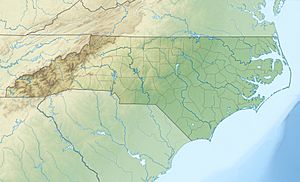Trent River (North Carolina) facts for kids
Quick facts for kids Trent River |
|
|---|---|
|
Location of Trent River mouth
|
|
| Other name(s) | Tributary to Neuse River |
| Country | United States |
| State | North Carolina |
| County | Craven Jones Lenoir |
| City | Trenton New Bern |
| Physical characteristics | |
| Main source | Mathews Creek divide about 3 miles north of Pink Hill, North Carolina 42 ft (13 m) 35°06′04″N 077°44′47″W / 35.10111°N 77.74639°W |
| River mouth | Neuse River New Bern, North Carolina 0 ft (0 m) 35°06′04″N 077°02′12″W / 35.10111°N 77.03667°W |
| Length | 87.15 mi (140.25 km) |
| Basin features | |
| Progression | generally east |
| River system | Neuse River |
| Basin size | 549.95 square miles (1,424.4 km2) |
| Tributaries |
|
| Bridges | Old Pink Hill Road, NC 11, Davis Mill Road, Mark N. Smith Road, Perry Buzzard Road, US 258, Pleasant Hill Road (x2), Chinquapin Chapel Road, Middle Road, NC 41, US 17, US 70 |
The Trent River is a freshwater river in eastern North Carolina. It flows through a flat area called the coastal plain. The river starts about 15 miles (24 km) southwest of Kinston, North Carolina. It then flows east through Lenoir, Jones, and Craven counties. The Trent River eventually joins the Neuse River in New Bern, North Carolina. Small towns like Trenton and Pollocksville are located along its banks. At its widest, the Trent River is about 720 yards (658 meters) across. Many smaller streams and creeks flow into the Trent River, adding to its water.
Contents
River Journey
The Trent River travels about 87 miles (140 km) from its start to where it meets the Neuse River. It begins near Mathews Creek, about 3 miles (5 km) north of Pink Hill, North Carolina. From there, it generally flows towards the east.
Where the River Ends
The Trent River's journey ends when it flows into the Neuse River. This meeting point is in the city of New Bern, North Carolina. The Neuse River then continues its path towards the Pamlico Sound.
River Connections
The Trent River is part of a larger water system. It is a major branch, or tributary, of the Neuse River. This means the Trent River's water eventually becomes part of the Neuse River.
Smaller Streams Joining the Trent
Many smaller streams and creeks flow into the Trent River along its path. These include streams like Horse Branch, Beaver Creek, and Jumping Creek on one side. On the other side, streams like Tuckahoe Creek, Cypress Creek, and Mill Creek also join the Trent. These smaller waterways help keep the Trent River full of fresh water.
Bridges Over the Trent
Many bridges cross the Trent River, helping people travel across it. Some of these bridges are part of important roads like US 258, US 17, and US 70. These bridges connect communities and make it easier to get around the region.
Images for kids
-
Aerial photograph of the confluence of the Trent and Neuse Rivers. East is up. The city of New Bern is on the left. The unincorporated community of James City is to the lower right. The Trent flows from the bottom center of the picture.





